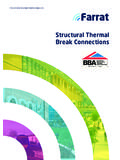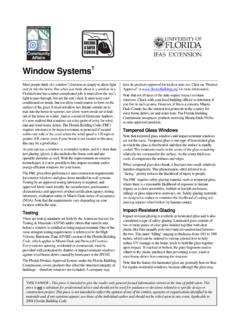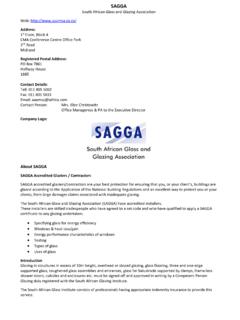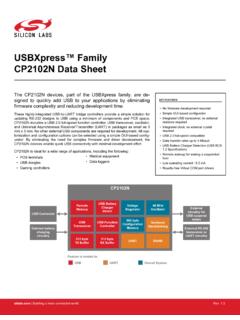Transcription of Structural Thermal Break Connections - Farrat
1 StructuralThermal Break ConnectionsVersion 15aFarrat Thermal Breaks2 IntroductionThermal Break plates are high performance Thermal insulators used between both horizontal and vertical Connections of internal and external elements to prevent Thermal / cold bridging. They provide a simple, economical and extremely effective solution to meeting Part L of the building Requirements by way of reducing both heat loss and the risk of internal condensation. Farrat Thermal breaks can also be used in hot climate conditions to insulate the cool, air conditioned interior, from the hot outside conditions. In 2007, responding to a request from a designer who was concerned with cold bridging on a project, Farrat Isolevel began manufacturing Thermal breaks for buildings. Changing legislation in response to climate change and energy saving has meant that Farrat now supply tens of thousands of Thermal Break plates for the UK and overseas market each year. Constantly driven by engineering excellence, Farrat continue to lead the way in the development of the Thermal Break plate Thermal breaks are accredited by the Steel Construction Institute (SCI) under the Assessed Product Quality Mark Scheme and manufactured under our ISO 9001:2008 Quality Assurance system.
2 Farrat Thermal breaks also meet the NHBC s technical take pride in providing our customers with a high level of service from technical support through to manufacturing accuracy and timely deliveries to site. Typical ApplicationsThe four primary Connections where Farrat Thermal breaks are used are as follows: Steel to Steel Steel to Concrete / Masonary Steel to Timber Concrete to ConcreteThermal Breaks are used in new build and refurbishment projects in the following building elements: Farrat Thermal Break PlateFarrat Thermal Break plateInternal steelworkExternal balconyExternal steelworkFig steel to steel connectionFig steel to concrete connectionConcrete Fa ade system Connections to the primary frame Brise-Soleil and Canopies Roof plant room columns Balustrading Connections of external to internal primary building elements Isolation of sub-structure and basement structure elements External balconies External staircases Man-safe/cleaning systems Connections to existing structuresWhy choose Farrat Structural Thermal breaks?
3 Steel Construction Institute (SCI) Assessed Product"SCI Assessed" is an established quality mark that has been awarded to testify that the technical data and Structural design methodology for Farrat Thermal breaks has been independently verified by material properties were verified by SCI following testing to an appropriate European building product standard and by an approved Nando Accreditation Body. NHBCF arrat Thermal breaks meet the NHBC s Technical requirements. NHBC accepts the use of Farrat TBK and TBL Thermal Break materials for use in Structural applications as set out in the SCI AssuranceFarrat Isolevel Limited operates an ISO 9001:2008 quality assurance system. All Thermal breaks are manufactured under this system. Dynamic Testing Static Compression Testing Transmissibility Testing Isolated Foundation Testing Shock Testing Creep Testing Cantilever Beam Testing Thermal Break Heat Transfer TestingOur in-house testing capabilities include:Fig Farrat research & development laboratoryFig connection with Thermal Break ( Farrat research & development laboratory) Farrat Thermal Breaks4 Specifications Construction drawings should show a fully detailed connection or one communicating the design intent with a supporting specification (NBS or similar).
4 The Architect is normally responsible for ensuring that the connection meets the requirements of the building Regulations Part L (SAP). Design Output - Thermal performance / Thickness ( Farrat TBK or Farrat TBL) The Structural Engineer is normally responsible for designing the connection or providing a performance specification for the steelwork fabricator. Design Output Strength ( Farrat TBK or Farrat TBL) Sample Specification for a project using Farrat TBK National building Specification (NBS)NBS Clause:G10/ 350 Thermal Break Connection Plate Manufacturer Farrat Isolevel Ltd, Balmoral Road, Altrincham, Cheshire, WA15 8HJ, Tel: +44 (0)161 924 1600, Fax: +44 (0)161 924 1616 Product Reference Farrat TBK Thickness 25 mm Plate Size As Drawing number or to be determined by the connection designer Hole Size & Positions As Drawing number or to be determined by the connection designer Accreditation SCI Assessed Product/ NHBCF arrat Thermal Breaks - Material PropertiesPROPERTIES FARR AT TBKFARR AT TBLC haracteristic Compressive Strength, fck (N/mm , MPa) 31289 Design value for compressive strength, fcd (N/mm , MPa)25070 Elastic Modulus (N/mm , MPa)51782586 Density (Kg/m )14651137 Water Absorption (%)0.
5 Conductivity (W/mK)0 . (may vary)AmberBlackThicknesses available (mm) ++5, 10, 15, 20 & 255, 10, 15, 20 & 25 Temperature Resistance (oCelcius)*+250 short term (Max)+210 long term (Max)-180 (Min) Farrat Thermal breaks are manufactured from high performance materials. We offer two grades, Farrat TBK and Farrat TBL. The materials have been independently tested and accredited by the Steel Construction Institute (SCI) under the Assessed Product Quality Mark Scheme. In the majority of applications Part L is satisfied by using plates between 5 & 25mm in thickness.++ Multiple plates can be provided for applications where thicknesses greater than 25mm are required.* Fire performance of Connections - please refer to page :The following information is required: Material Type Farrat TBK or Farrat TBL Plate dimensions Plate thickness Size and number of holes Quantity Delivery locationOrdersA fully dimensioned drawing is normally required for each type of plate with a unique project and plate reference prior to is undertaken in accordance with our ISO 9001 Accreditation.
6 Prior to delivery all Thermal breaks are labelled with the fabricator s unique Thermal Breaks are bespoke products and early procurement is recommended. Where very large orders are envisaged we are happy to work with the customer to plan phased deliveries. We aim to start manufacturing within 3 days of customers placing an order, The despatch date will be advised at point of The normal procurement process for Thermal breaks in a steel framed structureFig Typical Thermal Break fabrication drawingProject EngineerSteelwork FabricationThermal Modelling SpecialistSpecificationNational building Specification (NBS) - Section G10/Fabrication Drawing Material Plate Size & Thickness Hole Size & Position QuantityResponsibility - Thermal PerformanceMaterial ( Thermal conductivity) & ThicknessDesign ApprovalsFarrat Technical SupportResponsibility - Structural performance Fully Designed Connection or performance SpecificationCONSTRUCTION SITEP roject Architect Thermal Break Project Documentation-Drawings + SpecificationSteelwork Fabrication Design Office 21345 Farrat Thermal Breaks6 Design Consideration - Thermal PerformanceThermal performance of the building EnvelopeThere are very few standard construction details between projects and consequently the detailing of the building envelope and penetrations through the envelope can vary significantly.
7 The calculation of Thermal performance and compliance with codified requirements can be complex. There are two aspects to Thermal performance of the building envelope, heat loss and condensation risk. Both of these issues are covered by building Regulations, and guidance on meeting the building Regulations is given in various Approved Documents (England and Wales), Technical Handbooks (Scotland) or Technical Booklets (Northern Ireland). These documents currently all require heat loss and condensation risk to be assessed in accordance with the same British Standards, European Standards and BRE LossHeat loss is quantified using three parameters, depending upon the nature of the element causing the heat loss. For plane elements such as floors, walls and windows, the designer determines a U-value, which is the heat loss per unit projected area per unit temperature difference, expressed in Watts per square metre per Kelvin (W/m K) For linear elements, such as the interface between a window and a wall opening, or a corner where two walls meet, the designer determines a linear Thermal transmittance, or Psi-value ( -value), which is the additional heat loss per unit length per unit temperature difference, expressed in Watts per metre per Kelvin (W/mK) For localised elements, such as a Structural member penetration through a wall, the additional heat loss due to the penetration is expressed as a point Thermal transmittance or Chi-value ( -value), which is the additional heat loss due to the element per unit temperature difference, expressed in Watts per Kelvin (W/K) Connections that penetrate or bridge the insulation layer normally require a -value to be determined.
8 The designer must analyse or measure the heat loss through the construction both with and without the penetration. The difference between these values is the -value which is the residual heat loss due to the is impractical to measure the heat loss through most real penetrations due to their size and complexity. A more practical and cost-effective approach is for the designer to use computer modelling software based on techniques such as Finite Element Analysis (FEA). Fig Half-detail of penetration as analysedFig Close-up of penetration detailFigures and show an FEA model of a penetration utilising a 25 mm Farrat TBK Thermal Break , combined with Thermal isolating washers to maximise the effectiveness of the Thermal Break (only one-half of the detail is modelled the detail is symmetrical). For the purposes of analysis the FEA model must include the entire wall construction from the inside to outside, including all dry linings, external finishes and the penetration detail, as has been done for the analyses described Risk The Specifier will usually identify indoor and outdoor temperatures and relative humidity conditions under which condensation must not occur.
9 Guidance on suitable conditions is given in BS 5250 Code of Practice for the Control of Condensation in Buildings. From these conditions it is possible to determine the allowable minimum temperature on the construction detail below which there would be a risk of condensation. FEA and similar analysis methods allow the temperature distribution to be predicted, as shown in the previous Specifier must identify temperature and relative humidity conditions under which condensation is not permitted. The Specifier must also state the limiting -value for a single size of the connection is then determined by reference to Structural requirements and the connection can then be analysed to determine its Thermal best Thermal performance will always be obtained with the least net cross-sectional area of bolt Connections through the Thermal Break , the smallest area of Thermal Break and the use of the thickest possible Thermal practice is to locate the Farrat Thermal Break in the primary insulation layer of the wall or roof, and to fill the space around the connection with Richard HarrisSenior Associate, Consultancy Fig Predicted temperature distribution with no Thermal breakFig Predicted temperature distribution with Farrat TBK Thermal pad and Thermal isolating washersFigure shows the predicted temperature distribution through the penetration without a Thermal Break .
10 The temperature on the steelwork on the warm side of the cladding system is C and the heat loss ( -value) is shows the predicted temperature distribution with a Farrat TBK Thermal pad and Thermal isolating washers. The temperature on the steelwork on the warm side of the cladding system is increased to C and the heat loss ( -value) is reduced to W/K, a 73% decrease in the heat Thermal Breaks8 Design Consideration - Structural PerformanceThermal breaks are normally used in protected fa ades or roof systems. In general, steelwork Connections should be designed in accordance with the latest SCI guidance publications as listed below:Simple ConnectionsSCI-P212: Joints in steel construction. Simple Connections (BS 5950-1).SCI-P358: Joints in steel construction. Simple joints to Eurocode 3. Moment Connections SCI-P207: Joints in steel construction. Moment Connections (BS 5950-1).SCI-P398: Joints in steel construction. Moment joints to Eurocode , additional design checks should be carried out for Connections that include Farrat Thermal Break plates between the steel elements as follows:1.








